
If you’re in search of bathroom tile combinations, paint color suggestions, lighting ideas, and everything in between, this post presents five bathroom design concepts that cater to a variety of tastes and budgets!
You can expect to see a combination of neutral bathroom ideas along alongside earthy-toned bathrooms infused with modern organic influences. Thanks to designer Allison Campbell from Allison Campbell Design, I’m excited to share all the sources and details with you. This way, you not only can admire these stunning bathroom designs but also learn which elements were used to transform these spaces.
Let me know which bathroom design is your favorite! And, if you’re liking these inspiring bathrooms by Allison Campbell, make sure to see other spaces by this talented Utah interior designer:
– Top 4 New Bedroom Design Ideas.
– New Kitchen and Dining Room Design Ideas.
– Top 10 Pantry Organization Ideas.
– New Great Room Design Ideas.
– New Butler’s Pantry Design Ideas.
– New Laundry Room Design Ideas.

The first bathroom we will be seeing today is a bathroom featuring organic modern influences. A custom Rift White Oak vanity, along with matte black hardware, is accentuated with a 5×5 black and white tile. A large mirror with a thin black metal frame reflects more light into the space while a large concrete-looking hexagon tile anchors the space. This look feels current and it exudes personality.
Vanity: Custom – similar style: Miller 58″ Single Wide Sink Vanity.
Wall Paint Color: Benjamin Moore Swiss Coffee.
Floor Tile: Makoto 10″ x 11.5″ Hexagon Matte Porcelain Tile in Kuroi Black.

Mirror: Thin Black Metal Mirror – Others: Thin Framed Wall-Mounted Vanity Mirror (Set of 2) & Linden Rectangular Pivot Mirror.
Sconces: Fulton 1-light Wall Sconce.
Hardware: Top Knobs Clarence Pull, Flat Black.
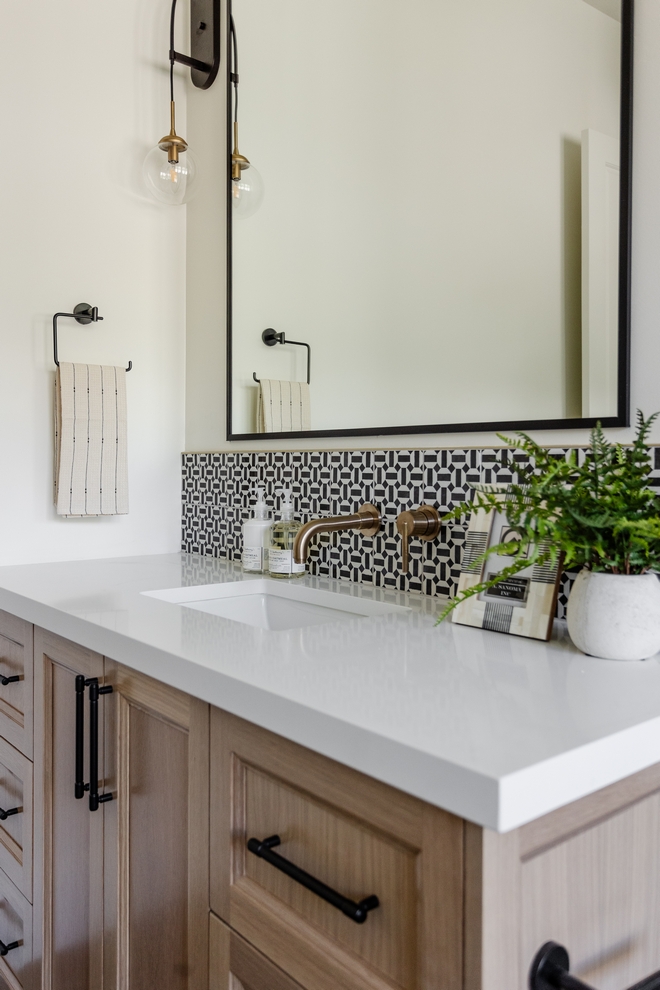
Countertop: Silestone Blanco Zeus with mitered edge.
Backsplash: Cloé 5″ x 5″ Glossy Ceramic Tile in Loire.
Faucet: Delta Trinsic Single Handle Wall Mount Bathroom Faucet Trim in Champagne Bronze.
Sink: Kohler Caxton Sink.
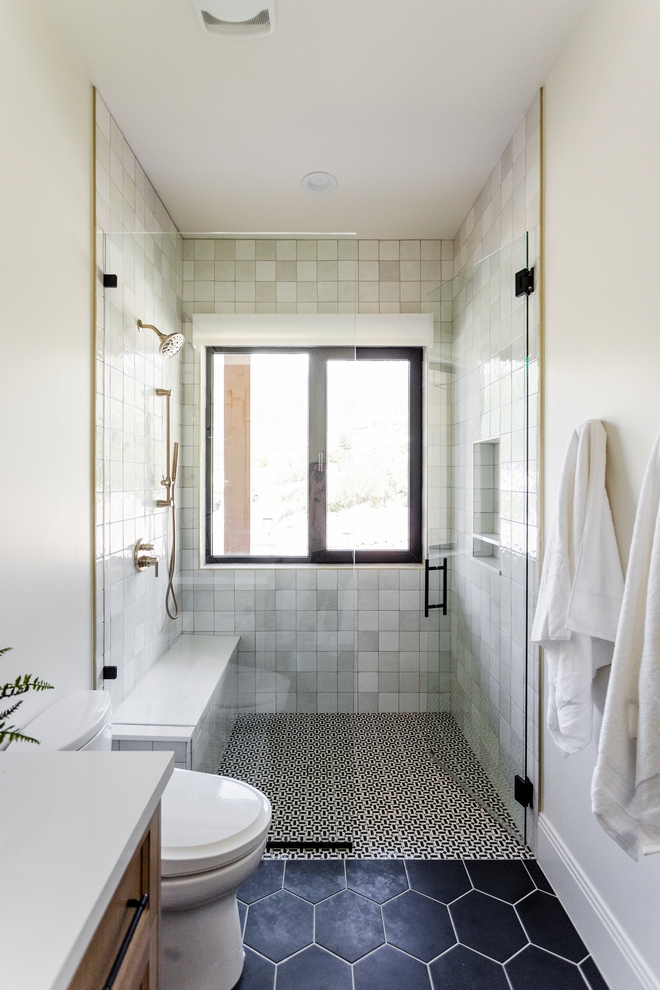
Wall Tile: Cloé 5″ x 5″ Glossy Ceramic Tile in White.
Shower Floor Tile: Cloé 5″ x 5″ Glossy Ceramic Tile in Loire.
Floor Tile: Makoto 10″ x 11.5″ Hexagon Matte Porcelain Tile in Kuroi Black.
Grout (Floor & Walls): Mapei – Warm Gray 93.
Shower Faucet: Delta.
(Click on items to Shop)

Calmness is the first word that comes to my mind when I look at this primary bathroom. Featuring a fairly neutral color scheme, this bathroom opens directly to the dressing room and primary bedroom. A stone-looking porcelain floor tile, set in a herringbone pattern, creates a natural feel to the space, whereas a grasscloth wallcovering delivers some soothing texture to the space. Well-balanced brass accents add the warmth that every bathroom craves.
Wall Paint Color: Benjamin Moore Swiss Coffee.
Cabinets: Custom, Rift White Oak.

Countertop: MSI Calcutta Arno.
Sinks: Kohler Caxton Sink.
Faucets: Brizo Litze Widespread Lavatory Faucet with High Spout.

Accent Wall Wallpaper: Kendari Grass Cream – If you prefer to get this look with tile, the “Thaddeus 24″ x 48″ Porcelain Wall & Floor Tile” is a great option!

Cabinet Pulls: Kingsmill Pull 6 5/16 Inch, Honey Bronze.

Mirrors: Flat Mirror.

Sconces: Savoy House 9-9771-2-322 Winfield 2-light wall sconce warm brass.

Accent Tile: Calacatta Gris Picket Mesh – similar: Arabescato Carrara Picket Honed Marble Tile & Arabescato Venato White Picket Honed Marble Tile. Grout: Mapei – Frost 77.
Bathroom Pendant Light: Marine Outdoor Pendant – Others: Headlands Rattan Bell Pendant & Benit Medium Sculpted Chandelier.

Table: Dakota Fields, White – similar: Lark Manor.

Tub Filler: Brizo Litze Single-Handle Freestanding Tub Filler – Others: Contento Single Handle Floor Mounted Freestanding Tub Filler & Purist Floor-Mount Bath Filler Trim with Handshower.
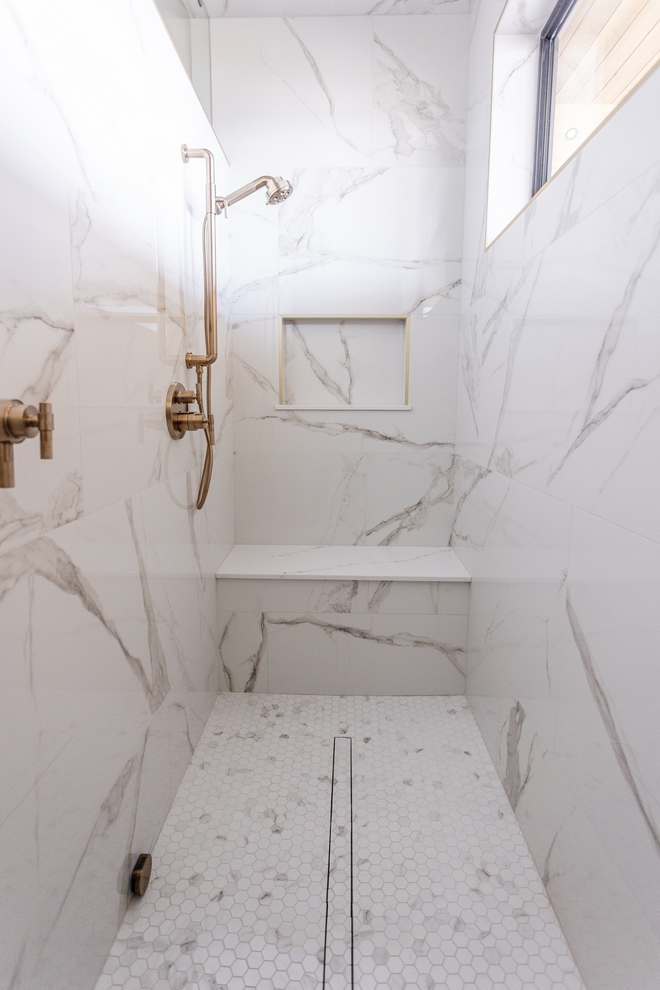
Shower Tile: 24″ x 48″ Glazed Porcelain Marble Look Wall & Floor Tile – Horizontal Brick.
Floor Tile: Hexagon 2″ x 2″ Marble Honeycomb Mosaic Wall & Floor Tile.
Schluter: Stain Brass.

Floor Tile: Elysium Waystone Pearl 12×24 – Others you Might Like: Bianco 12″ x 24″ Porcelain Concrete Look Wall & Floor Tile (similar style), Core Travertine 12″ x 24″ Porcelain, BB Concrete 12″ x 24″ Porcelain Concrete Look Wall & Floor Tile, Pulpis 3″ x 13″ Beveled Porcelain Marble Look, Norde Grigio 12″ x 24″, 12″ x 24″ Porcelain Field Tile & Nambia 12″ x 24″ Porcelain Marble Look.

Creating Neutral Yet Playful Kids’ Bathrooms: Opting for neutral kids’ bathrooms is a wise decision, as it allows you to avoid immediate renovations once your child becomes a teenager. However, that doesn’t mean the design can’t be enjoyable! In this space, the designer incorporated penny-round tiles on the flooring with a custom pattern, adding a playful touch. Plus, these tiles feel so fun under little toes! 🙂

Bathroom Paint Color: Benjamin Moore Swiss Coffee.

Vanity: Custom, Rift White Oak – Other Best Sellers: Reajean 48″ Single Vanity & 48” Single Bathroom Vanity with Quartz Top.
Hardware: Cumberland Pull, Honey Bronze.

Mirror: Metal Rectangle Wall Mirror.
Sconces: Savoy House York 16 Inch Wall Sconce.

Countertop: Hanstone Campina LO711.
Sink: Kohler Caxton Sink.

Bathroom Faucet: Trinsic Two Handle Widespread Bathroom Faucet in Champagne Bronze.

Floor Tile: Penny Round 11-7/8 ” x 12-5/8 ” Porcelain Mosaic Floor & Wall Tile, alternating “Plus” signs in Marine & Vermilion. Grout (all): Mapei – Cobblestone 103.

Tile: Arizona Tile Touch 12×24, Snow – similar: 11.69” x 23.5” Porcelain Wall & Floor Tile.
Plumbing: Delta Trinsic Monitor 14 Series H2Okinetic Tub & Shower Trim in Champagne Bronze.

As we just talked about, neutral bathrooms are always a safe and timeless choice, but adding some color and interest with the right tiles and paint color can be so fun. Offering a neutral base, this is a bathroom design that perfectly balances neutral elements with hints of color and vibrant patterns.
Schluter: Satin Brass.
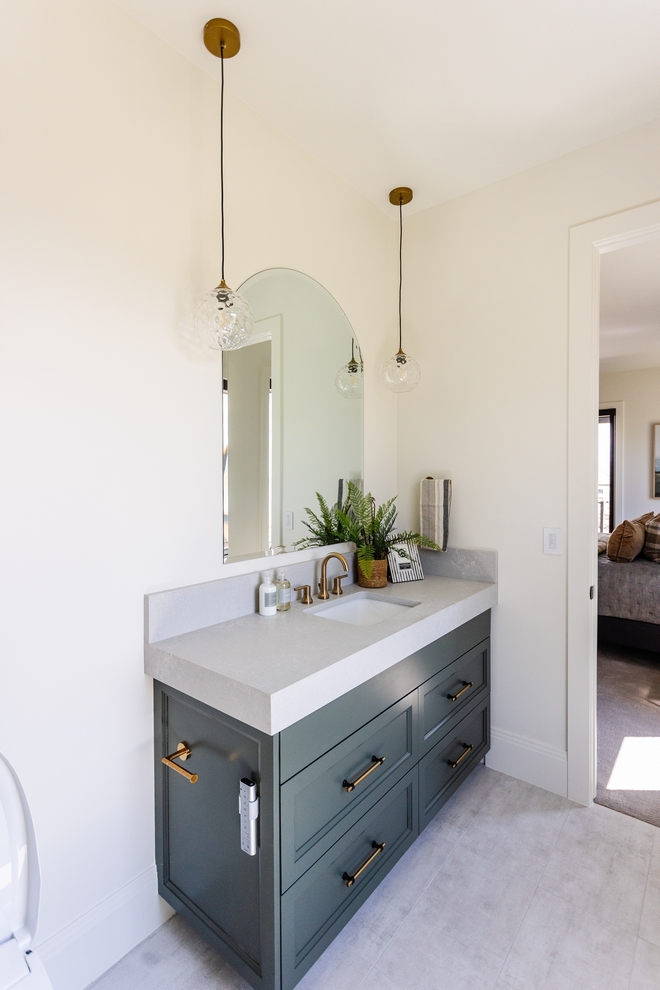
Lighting: Discontinued – Others you Might Like: Dawson 1 – Light Single Pendant, Cooper Ribbed Glass Pendant & Bertina 1 – Light Single Pendant.
Floor tile: Bianco Lappato 12×24, Perla. Grout: Mapei – Warm Gray 93.
Mirror: Frameless Arched Mirror.

Vanity Paint Color: Sherwin Williams SW 6187 Rosemary.
Hardware: Top Knobs Bit Pull, Honey Bronze & Flat Black.

Countertop: HanStone Quartz Coast – MV514.

Faucet: Trinsic Two Handle Widespread Bathroom Faucet in Champagne Bronze.
Sink: Kohler Caxton Sink.

Green Shower Tile: Makoto Midori Green tile 2.5×10. Grout: Mapei – Warm Gray 93.
Shower Faucet: Delta Trinsic Monitor 14 Series H2Okinetic Shower Trim in Champagne Bronze.

Hex Accent Tile: Allora 8.5″ x 10″ Matte Telaio Hexagon Deco Porcelain Tile. Grout: Mapei – Warm Gray 93.

Shower Floor tile: 3/4″ x 3/4″ Penny Round 360 Charcoal. Grout: Mapei – Warm Gray 93.

A lot of people tend to neglect or use lower-quality elements in their basement bathroom, but that’s not the situation in this case. Designer Allison Campbell has incorporated a stunning custom vanity, painted in Sherwin Williams SW 6236 Grays Harbor. Additionally, the shower features the popular Cloe Tile in White, arranged in an inspiring pattern.
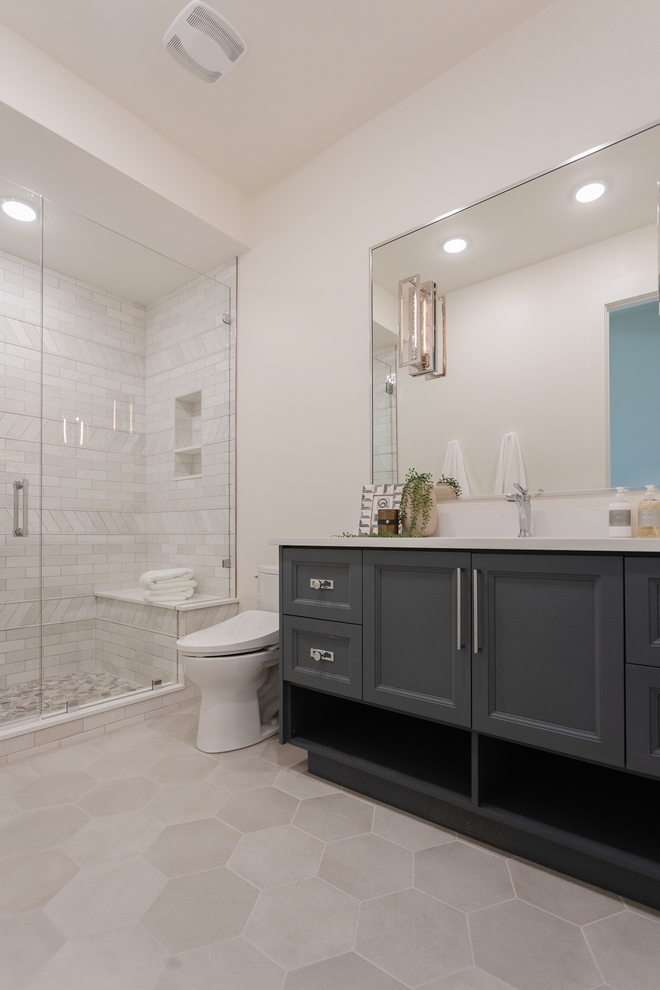
Floor tile: Makoto 10″ x 11.5″ Hex Matte Kumo Grey – Grout: Mapei – Warm Gray 93.

This combination of knobs with backplates is one of my favorites!
Cabinet Hardware: Kinney Pulls & Knobs with Backplates.
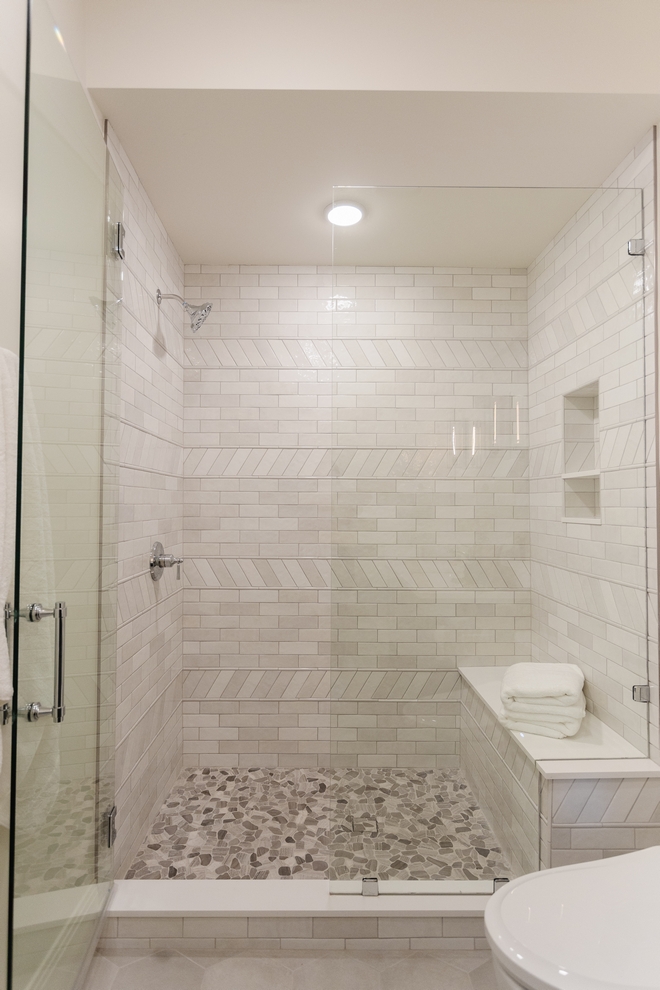
Shower Tile: Cloe Tile, White – Grout: Mapei – Warm Gray 93.

Shower Wall Tile Pattern: Cloe Tile White, 6 Row, Cloé 0.5″ x 8″ Ceramic Jolly Miter Edge in White & 1 row Cloe Tile White, Alternating diagonal.

Shower Bench Top: Silestone Blanco Zeus.

Shower Floor tile: Emser Tile Cultura – 12″ x 12″ Pebble and Rock Floor Tile – Honed, Autumn.

Countertop: Silestone Blanco Zeus.
Sconces: Savoy House Clifton 1-Light Wall Sconce in Polished Nickel.
Faucet: Delta Dorval in Polished Nickel – similar here.
Mirror: Metal Rectangle Wall Mirror.
Sink: Kohler Caxton Sink.
I hope you have a blessed week, and thank you so much for being here and for your loyalty. Your presence is a blessing and it doesn’t go unnoticed!”🙏– Luciane @HomeBunch
Photography: @amandapeterson.photo.
Thank you for shopping through Home Bunch. For your shopping convenience, this post may contain AFFILIATE LINKS to retailers where you can purchase the products (or similar) featured. I make a small commission if you use these links to make your purchase, at no extra cost to you. Shopping through these links is an easy way to support my blog and I appreciate and I am super grateful for your support! I would be happy to assist you if you have any questions or are looking for something in particular. Feel free to contact me and always make sure to check dimensions before ordering. Happy shopping!








“Dear God,
If I am wrong, right me. If I am lost, guide me. If I start to give-up, keep me going.
Lead me in Light and Love”.
Have a wonderful day, my friends and we’ll talk again tomorrow.”
with Love,
Luciane from HomeBunch.com